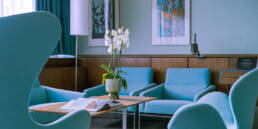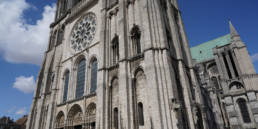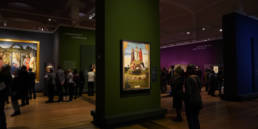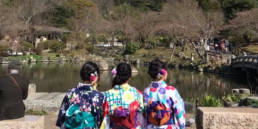The fabulous building built in 1872 by Odon Lechner, the prime architect of Budapest’s Secession movement, houses an impressive permanent collection of decorative arts modeled on that of London’s V+A. Unfortunately, for reasons completely obscure to the general public and even to museum staff, none of this collection is actually on display (and attempts to consult items in storage for study purposes are not well met). It is likely due to lack of funds. Temporary exhibitions are shown in some of the exhibition spaces.

On our recent visit we saw an show on Zsolnay ceramics, decorative works produced from the late nineteenth century onwards in the southern Hungarian town of Pecs. While the company produced tea ware, vases and stuff, their work was considered particularly apt for architectural decoration, because of a special heat and cold resistant glaze. The decorative arts museum itself is ornamented with these ceramics, and there is a section of the exhibition dedicated to this, with some of the original plans exposed.

The building is an exciting example of decorative art in itself. A brick and stucco facade are topped by a green roof punctuated with domes. The domes have yellow pinnacles that stick out and give the impression that the building is constantly in movement, like it is dancing a jig. White floral plaques articulate the faux-stone architecture.

The main door is located within a grand antichamber, where the movement calms down but you are affronted with a riot of colour and pattern. Brick and stone hold up a flower chaped ceramic ceiling of yellow and white, with a beautiful floral pattern. You are led up the staircase by a wacky yellow ceramic glazed handrail.
Just inside the door, you look up into an irregular opening, three stories high, to a tiffany-type stained glass of most unusual shape, that plays with convex and concave curves. Beyond this darker section of the entrance hall, however, you are struck by the contrast of the light-filled white interior to the green and white exterior.

The main exhibition spaces all look onto a central opening that is topped with a wrought iron and glass ceiling reminiscent of 19th century Paris. The white stucco interior was likely designed to provide a light and neutral backdrop to the museum’s colourful collection.
For the art-deco obsessed, this museum is fabulous even just as a space to visit.
Museum info
Iparmuveszeti Museum
H-1091 Budapest, Üllői út 33-37. (Underground M3 – Corvin negyed station)
Open Tuesday-Sunday: 10.00-18.00
There is no English language website.
Sign up to receive future blog posts by email
Alexandra Korey
Alexandra Korey aka @arttrav on social media, is a Florence-based writer and digital consultant. Her blog, ArtTrav has been online since 2004.
Related Posts
September 18, 2019
Re-Discovering Chartres: the Gothic Cathedral and Beyond
March 31, 2019
Mantegna and Bellini – Berlin exhibition review
May 1, 2018




